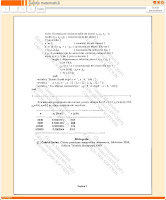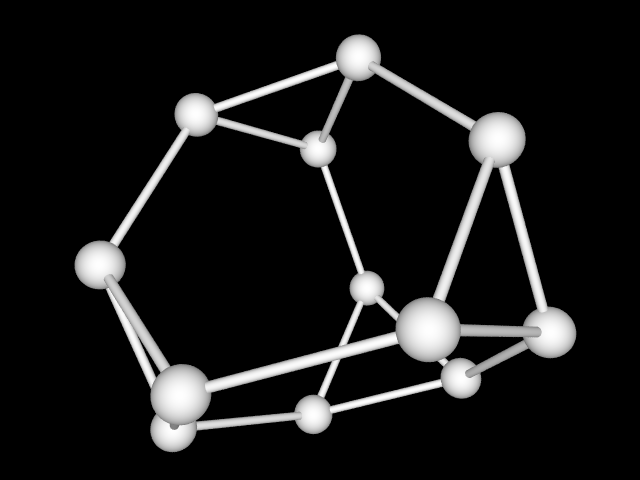
Exactitate + Corectitudine + Rigoare = Matematică| unibuc.ro (GM-115)
De la complicat ... la simplu, sau de la Matematica la ... Informatica.
De la simplu ... la complicat, sau ... de la Informatica la ... Matematica.
Nota (pseudo-ecuatii):
a) Algorithm = Logic + Control (Robert Kowalski - Imperial College, London, 1979 - Comm. of the ACM)
b) Algorithms + Data Structures = Programs (Wirth Niklaus - Prentice-Hall, Englewood Cliffs, N.J., 1976)
1. O problema a lui Gauss.
Enunt (2.4 Exemple de probleme rezolvate): Un vas conţine 2000 litri dintr-un lichid cu o concetraţie de 80% alcool. În fiecare zi se scot din vas 15 litri şi se înlocuiesc cu alţi 12 litri dintr-un lichid a cărui concentraţie în alcool este de numai 40%. După câte zile concentraţia lichidului din vas ajunge la 50% ?
([1] GABRIEL SUDAN, Câteva probleme matematice interesante, Biblioteca SSM, Editura Tehnică, Bucureşti, 1969.
[2] MARIN VLADA, O problemă a lui K.F. Gauss rezolvată cu calculatorul, Gazeta Matematică, nr. 5/1995)


Rezolvare (2.4 Exemple de probleme rezolvate):
- Editia electronica a Gazetei Matematice: http://www.gazetamatematica.net
Sursa: http://ebooks.unibuc.ro/informatica.htm
2. Ştiinţă versus Jurnalism
 (doar pentru cei ... ce au răbdare de a înţelege un raţionament corect): "Anul 1989 a început şi s-a terminat cu ziua de Duminică. Lucrul acesta se întîmplă o dată la 300 de ani?" + LINK intern
(doar pentru cei ... ce au răbdare de a înţelege un raţionament corect): "Anul 1989 a început şi s-a terminat cu ziua de Duminică. Lucrul acesta se întîmplă o dată la 300 de ani?" + LINK intern Nota: Fotografie "centrul Caii Lactee" - Centrul Galactic - In interiorul vartejului (telescopul Hubble); sursa: www.descopera.ro
3. Ocean's Depth and Volume - "A group of scientists used satellite measurements to get new estimates of these values, which turned out to be 0.3 billion cubic miles (1.332 billion cubic kilometers) for the volume of the oceans and 12,080.7 feet (3,682.2 meters) for the average ocean depth. "
sursa: http://www.livescience.com/ | http://news.yahoo.com
4. Pompeiu–Hausdorff distance and Applications:

"In computer vision, the Hausdorff distance can be used to find a given template in an arbitrary target image. The template and image are often pre-processed via an edge detector giving a binary image. Next, each 1 (activated) point in the binary image of the template is treated as a point in a set, the "shape" of the template. Similarly, an area of the binary target image is treated as a set of points. The algorithm then tries to minimize the Hausdorff distance between the template and some area of the target image. The area in the target image with the minimal Hausdorff distance to the template, can be considered the best candidate for locating the template in the target.[3] In Computer Graphics the Hausdorff distance is used to measure the difference between two different representations of the same 3D object[4] particularly when generating level of detail for efficient display of complex 3D models."
Sursa: http://en.wikipedia.org/
- Dimitrie Pompeiu (1873-1954): http://www.cs.ubbcluj.ro/
- Felix Hausdorff (1868 – 1942): http://en.wikipedia.org/
1. Tyrrell Rockafellar, Roger J-B Wets, Variational Analysis, Springer-Verlag, 2005, pg.117
2. Francesco S. De Blasi, Pando Gr. Georgiev, Hukuhara's Topological Degree for non Compact Valued Multifunctions, Publ. Res. Inst. Math. Sci. Volume 39, Number 1 (2003), 183–203, pg.185
5. Discrete Mathematics - Journal on Discrete Mathematics

"The history of discrete mathematics has involved a number of challenging problems which have focused attention within areas of the field. In graph theory, much research was motivated by attempts to prove the four color theorem, first stated in 1852, but not proved till 1976 (by Kenneth Appel and Wolfgang Haken, using substantial computer assistance)"
sursa: http://en.wikipedia.org/wiki/Discrete_mathematics
6. Jocul Pac-Man -
 unul dintre cele mai populare jocuri video creat de compania Namco în anul 1980, http://en.wikipedia.org/
unul dintre cele mai populare jocuri video creat de compania Namco în anul 1980, http://en.wikipedia.org/
No comments:
Post a Comment
Note: Only a member of this blog may post a comment.